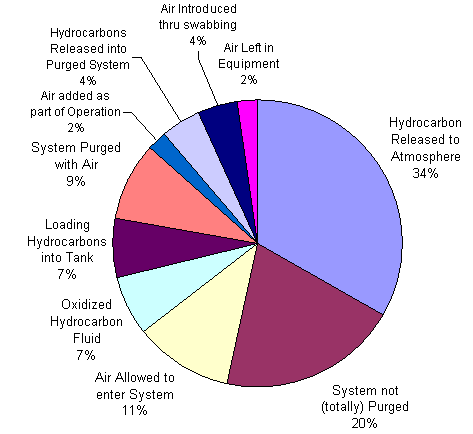Identifying Fire & Explosion Hazards |
 |
 Printable version of page content Printable version of page content
It is widely understood that air (which contains approximately 21% oxygen by volume; any other oxygen-containing gas mixture is also implied here) when mixed in the correct proportions with a hydrocarbon forms an explosive mixture. This can occur when air is deliberately used, or when air is inadvertently trapped in piping, vessels, and wellbores.
There are several ways that air/oxygen can form explosive mixtures with hydrocarbons:
- Planned air introduction during air-based operations or when piping and vessels are purged with air.
- Introduction of air during underbalanced operations or operations that create a vacuum (i.e. swabbing).
- Pockets of air created during the installation and servicing of equipment.
- The use of oxidizing chemicals (i.e. persulphates).
The figure below shows the types of air-hydrocarbon mixtures identified during the review of the case studies on this site.

Fuel - Air Mixtures Identified in Website Case Studies
A number of potential sources of oxygen are not well understood or obvious and deserve further explanation.
Oxidized (Weathered) Hydrocarbons
Liquid hydrocarbons in the presence of air may oxidize forming oxidized hydrocarbon products such as hydroperoxides, aldehydes, and ketones . These compounds can decompose during a small or sudden change in operating parameters such as pressure or temperature, releasing significant amounts of energy which may lead to explosions. Reaction rates will increase at the higher pressures and temperatures encountered subsurface.
The behaviour of oxidized hydrocarbons and the associated relevant mechanisms are not well documented or understood. Further research is needed to establish basic understanding of the various relevant mechanisms associated with oxidized hydrocarbons.
On-site Generated Nitrogen
Nitrogen can be generated on-site for well drilling and other applications such as purging, using a portable membrane separation units. The nitrogen provided by these units contains a small amount of oxygen (3% - 10%, by volume), depending on the flow rate, temperature and pressure of the compressed air feed.
These levels may pose an explosion risk at subsurface conditions; therefore, application-specific screening must be carried out to establish the maximum allowable oxygen concentration for safe operation.
back to top
|



